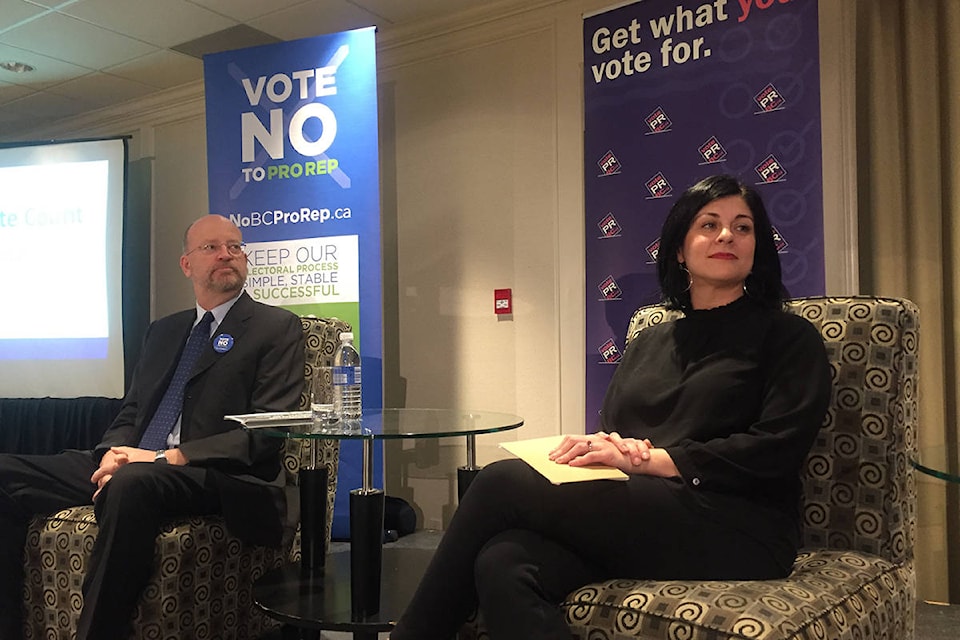B.C.’s current provincial voting system is either broken and needs to change to be more equitable to all voters, or is “simple, stable and successful” and should left as it is.
Those were the two points of view expressed Wednesday at a Kelowna Chamber of Commerce luncheon that featured speakers on both sides of the debate over proportional representation in B.C.
Maria Dobrinskaya, spokesperson for Vote B.C., the organization representing the yes side in the upcoming proportional representation referendum, and Bill Tieleman of No Proportional Representation BC, made their respective cases, with each arguing the pros and cons of both “pro rep” and the existing system known as “first-past-the-post.”
RELATED: To change, or not to change, that is the proportional representation referendum question
In first-past-the-post, individual elections are held in the 87 provincial ridings and the candidate who wins the most votes wins that riding’s seat in the B.C. legislature. The party with the most seats is then invited by B.C.’s lieutenant-governor to form the new government.
The current NDP government, with the backing of the B.C. Green Party, is proposing scrapping that system in favour of one of three versions of proportional representation: dual member proportional, mixed member proportional or rural-urban proportional.
Dual-member proportional would produce two representatives in each riding. The first seat would be awarded to the candidate who receives the most votes—similar to first-past-the-post. The second seat would be awarded to one of the remaining candidates so proportionality is achieved across the entire province using a calculation to award parties their seats in ridings where they had their strongest performances.
Mixed-member proportional would see voters get two votes—one to decide the MLA for the single-seat riding, and one for a political party. Seats in the B.C. Legislature would then be filled first by the elected candidates from the ridings and then by the party candidates based on the percentage of votes each party received in the overall provincial election.
Rural–urban proportional is a hybrid system that would use mixed-member proportional representation in rural areas and a single transferable vote in urban and semi-urban areas.
RELATED: B.C.’s proportional representation referendum: The case for switching to PR
Dobrinskaya argued first-post-the-post has lead to only one true majority government in B.C. in the last 18 years (2001), the rest being “false majorities,” where the governing party has received less than 50 per cent of all votes cast province-wide.
Because proportional representation would give other parties seats based on their share of the provincial vote, rather than winner-take all, single-seat riding votes, losing parties could gain seats in the legislature based on their share of the provincial vote and thus represent a wider number of voters.
She said under the three systems being proposed, 40 per cent of the votes would get a party 40 per cent of the seats.
But Tieleman, who described himself as a “dissident New Democrat,” said that could open B.C. up to having extremist parties represented in the legislature as the threshold for votes to get a seat is only five per cent.
He pointed to other countries where forms of proportional representation are used and said that has already happened including Sweden, Belgium and Germany.
He also said unstable coalition governments would become the norm in B.C. and pointed to Italy where there have been 62 governments in the last 72 years. Italy uses a form of proportional representation.
In fact, more than 90 per cent of the countries in the world use some for proportional representation, said Dobrinskaya.
“I believe the government should be a true representation of the people,” she said, adding proportional representation would force more cooperation between political parties and end what she called “policy lurch.” That is where one party comes to power and replace another after an election and spends time and money dismantling what the previous government did.
In addition to opposing a change, Tieleman said he is concerned about the process being used for the referendum. He does not believe such a fundamental change should be decided by a simple majority of 50 per cent plus one.He would like to see a requirement for at least 60 per cent for any change to pass. And he said there was no public consultation prior to the government announcing the referendum.
RELATED: B.C.’s proportional representation referendum: The case against switching to PR
The Kelowna Chamber of Commerce, while neutral on the issue of what form of voting should be used in future, is also opposed to the process.
Tieleman said it’s not clear how many ridings there will be in B.C. if proportional representation is adopted or how many MLAs there will be. There could be a maximum of nine more.
All in all, he said, a change to proportional representation will hurt local representation and diminish the accountability of local representatives in the B.C. Legislature.
Both Dobrinskaya and Tieleman agreed a lot of work will have to be done following the referendum if a change is approved.
If it is, the government says following the second election using proportional representation, a second referendum will be held to ask voters if they want to keep using the new system.
The mail-in referendum requires ballots to be mailed out to the public starting Oct. 22 and they must be returned by Nov. 30.
For more information on both sides in the referendum go to nobcprorep.ca and voteprbc.ca. For more information on the referendum, go to elections.bc.ca
